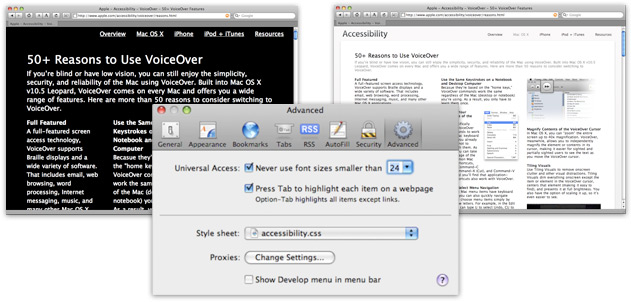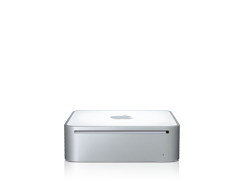Vision
If you have a vision disability, Mac OS X includes many features to assist you, including a built-in screen reader, voice commands, screen magnification, high-contrast settings, and other technologies and features described below.
VoiceOver
A full-featured screen reading technology for the visually impaired, VoiceOver provides full keyboard control of the computer along with spoken audio descriptions. Learn more
Application and Device Support
Built into Mac OS X, VoiceOver features compatibility with a wide range of applications and works so seamlessly with refreshable braille displays that you can start using them the moment you plug them in.
VoiceOver Downloads
You’ll find a variety of learning materials — including a “VoiceOver Getting Started” manual, podcasts, and more — on the VoiceOver downloads page.
Talking Alerts
When an application needs your attention, Talking Alerts automatically speak the contents of dialogs and alerts for you.
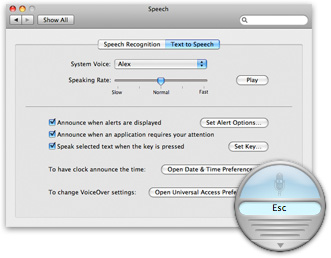
Text to Speech
If you don’t use a screen reader but have trouble reading text on your computer screen, you can have your Mac “speak” the text you select. To turn Text to Speech on, open System Preferences, click Speech, then open the Text to Speech pane. You can even set up a keyboard shortcut to initiate Speech.
As an alternative, you can select text you want your Mac to speak, then choose Speech from the application’s Services menu.
Talking Clock
Another system preference lets you instruct your Mac to automatically announce the time of day — on the hour, half hour, or quarter hour. Or you can use a voice command to have your Mac speak the time of day whenever you like.
Screen Magnification
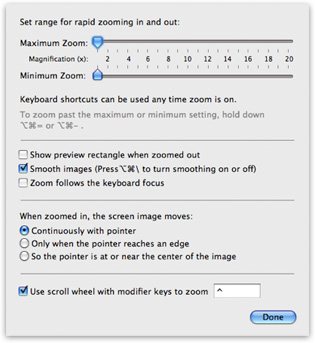
Enlarge the contents of your display at any time using Zoom, located in the Universal Access pane in System Preferences. Zoom lets you use the scroll wheel on a mouse, a trackpad gesture, or key commands to magnify the entire contents of your screen by up to 40x. Thanks to powerful Quartz rendering, text, graphics, and even video magnify perfectly without affecting system performance.
Use the Zoom dialog to set maximum and minimum values for instant zooming to a particular magnification. A preview rectangle outlines the portion of the screen that will be magnified when not zoomed in. The dialog lets you create custom key commands, and it offers three options for cursor tracking when magnified: keeping the cursor in the middle of the screen, automatically moving with the cursor, or moving only when it reaches the edge of the screen.
Cursor Magnification
In Mac OS X, you can scale the cursor so it's easier to see and follow when you move the mouse. The cursor remains scaled to the preferred size even when the cursor shape changes. The scaling remains in effect until you change it, even when you log out, shut down, or restart your Mac. And cursor scaling works in concert with other Mac OS X screen magnification technologies, allowing you to combine them in unique ways.
Display Adjustment
Mac OS X includes flexible adjustments for controling the characteristics of your display. These adjustments are systemwide, not application specific, so they provide a consistent view in every Mac application. You can increase or decrease contrast by switching the screen to white-on-black or black-on-white, and you can vary the contrast using a slider control. If you would like to remove all color from the screen, you’ll find controls for displaying everything in black and white or grayscale.

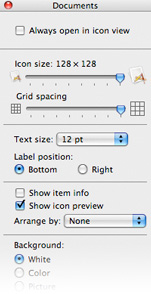
Finder View Options
Use View Options (Command-J) to adjust the text size of icon names (from 10 to 16 points) and their thumbnail previews (from 16 by 16 to 128 by 128 pixels). You can change the background, normally white, to any color to increase contrast. And you can adjust the grid spacing between icons as well.
You can apply View Options to the contents of a specific folder or to all folders systemwide. Because they’re independent of other Universal Access settings, such as Zoom, you can combine Finder View Options and Universal Access settings in a variety of ways.
Dock Magnification
The Dock offers a convenient way to access commonly used applications, files, and folders. Though the Dock can be quite small if you add a great many items, Mac OS X lets you set the default size of Dock icons so they're easier to see. You can also use Dock Magnification to automatically enlarge the icon currently under the mouse pointer.

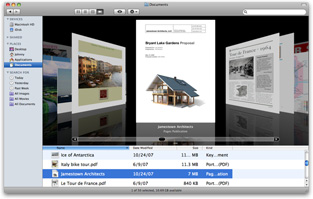
Cover Flow
New in Mac OS X Leopard, Cover Flow provides an ultralarge view of folder contents. Instead of a small, generic "thumbnail" icon, files appear in the Finder just as they appear when opened in an application. You can enlarge this view by stretching the window or adjusting the splitter bar in the window to provide a very large format that's much easier to see and navigate than traditional list, column, and icon views.
Safari Cascading Stylesheets (CSS)
The Safari web browser included with Mac OS X features additional Universal Access preferences for web browsing. For example, a checkbox can be set to prevent a web page from being displayed using fonts smaller than the minimum size you set, from 9 to 24 point. By default, pressing the Tab key in Safari navigates only the toolbar and the form elements on a page. Pressing Option-Tab will navigate every element. If you prefer, you switch this behavior so pressing Tab key by itself will navigate every element and pressing Option-Tab navigates only the toolbar and form elements.
Using the style sheet pop-up preference, you can apply a custom cascading style sheet, called a “css”, that changes the way a web site is displayed without requiring the web site author to make any changes. This is a great way to customize the appearance of web pages to suit your specific needs.
